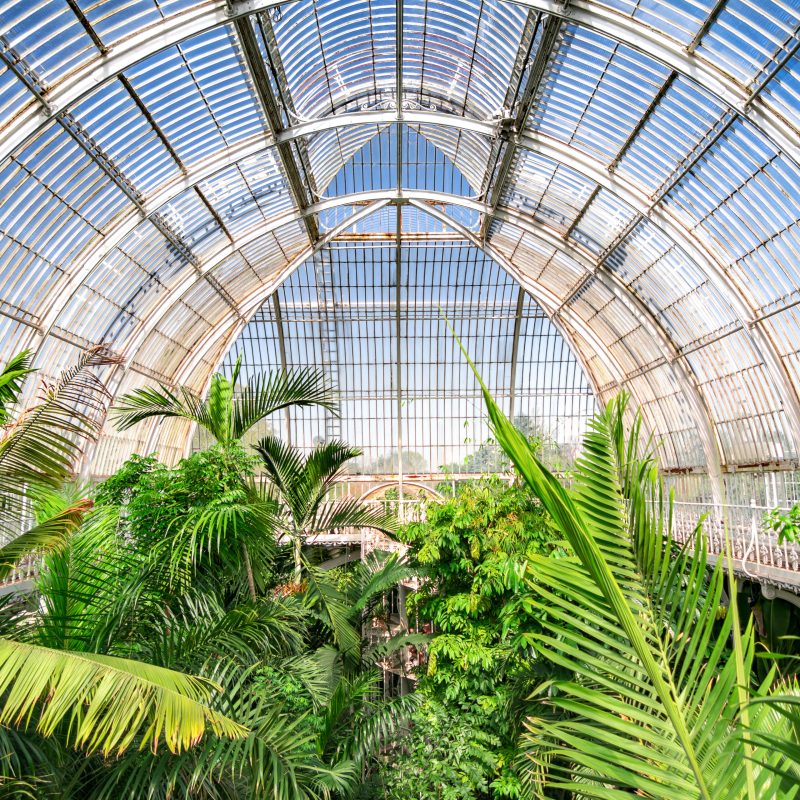
The Royal Botanic Gardens, Kew, known simply as Kew Gardens, is located in Richmond, a suburban town in southwestern London. The garden, a UNESCO World Heritage site, dates to the 18th century, when it was established on the grounds of a royal palace.
Videos by TravelAwaits
Today, the garden is a globally renowned scientific institution for plant and fungal research. The original 9-acre area has expanded to include 300 acres containing more than 50,000 living plants. With its Victorian glasshouses, arboretum, and artwork, there is a lot to see.
Here are eight of the garden’s attractions that no visitor should miss.

1. The Great Pagoda
The Great Pagoda was completed in 1762 as a gift for Princess Augusta, who founded Kew Gardens. When it was constructed, 80 dragons carved from gilded wood adorned the roofs of its 10 floors. The dragons were removed in 1784. There were rumors that they were sold to pay King George IV’s gambling debts, but it is more likely that they simply rotted over time. The Great Pagoda was restored in 2018, and the dragons are back. Eight of the first-floor dragons were produced in the traditional manner and hand-painted. The remaining 72 were 3-D printed in a robust polyimide material.
A circular staircase inside the pagoda allows visitors to climb to the top for spectacular views. There are a limited number of spaces available per time slot, and if you wish to climb the pagoda, you must pay an additional fee. There are 253 steps to the top.
If you choose not to climb to the top, you can look through the small room at the base of the pagoda at no additional cost. Here you’ll find information about the pagoda and its architect, Sir William Chambers. You’ll also find two automata. One shows the architect visiting Canton, China, where he studied pagodas. The other shows the royal family strolling through Kew Gardens. Handwheels at the bases of the automata allow you to control the moving parts.

2. The Japanese Landscape
Three garden areas make up the Japanese Landscape. The Garden of Peace, an area reminiscent of a traditional Japanese tea garden, features stone lanterns and a dripping water basin. Raked gravel and large rocks in the sloped Garden of Activity represent the movement of flowing water. The Garden of Harmony unites the two. All three combine to create a peaceful, manicured oasis.
At the center of the Japanese Landscape is the Chokushi-Mon, or Gateway of the Imperial Messenger. It was created for the Japan-British Exhibition of 1910 and is a replica of the Gate of Nishi Hongan-ji (Western Temple of the Original Vow) in Kyoto, Japan. Its finely carved wooden panels feature stylized flowers and animals that depict an ancient legend.

3. The Temperate House
The Temperate House, originally opened in 1863, is the world’s largest Victorian glasshouse. It has been an iconic landmark of Kew for more than 250 years. The Temperate House reopened in 2018 after a five-year renovation project. Filled with 10,000 individual plants, it is home to 1,500 species from Africa, Australia, New Zealand, the Americas, Asia, and the Pacific Islands, including some of the world’s rarest and most threatened temperate plants. All of the species require conditions above 50 degrees to survive.
Level pathways wind throughout the ground floor, and a balcony around the interior perimeter offers views from above. Note that the balcony is not wheelchair accessible.

4. The Treetop Walkway
You’ll find 14,000 trees in Kew Gardens. The Treetop Walkway provides an opportunity to get closer to those trees and offers views of the garden and the city beyond. Made of weathered steel that blends into the natural environment, the walkway stands 59 feet tall. It is 656 feet long and loops through the upper branches of beech, sweet chestnut, horse chestnut, and oak trees. The walkway offers a unique, ethereal perspective of nature. You’ll love watching bird and insect behavior at this height and hearing the breeze rustling the branches.
The 188 steps to the walkway are a manageable climb, since the steps are broken up into several flights and there’s a landing at the end of each flight. There is room on each landing to step out of the path of oncoming climbers to rest or simply take a few moments to admire the view. The walkway itself has chest-high railings, and several circular jut-outs along the way provide additional viewpoints. There is an elevator, but it was out of service on the day I visited. If you plan to use the elevator, check the Kew Gardens website for information about the elevator’s status. As I write this, the site says that the elevator is currently out of service.
There is no additional charge to access the Treetop Walkway. It closes an hour before the whole garden closes.

5. The Palm House
You can explore an indoor rainforest at the garden’s Palm House. The Palm House, which opened in 1848, was the first glasshouse to be built at Kew Gardens. Inside, you’ll find lush vegetation and dense, moist air. Many of the plants in the collection are endangered in the wild, and some are even extinct. Rainforest plants cover only 2 percent of the world’s surface but make up 50 percent of plant species. Look for the Madagascar periwinkle, now used to treat a number of different types of cancer; the rubber tree; the cocoa tree; and the cycads, or palm-like plants that were widespread more than 250 million years ago.

6. The Marianne North Gallery
With all there is to see at Kew Gardens, you might easily miss the attractive red brick building housing the Marianne North Gallery. But don’t hesitate to take a look inside — the exquisite interior, which incorporates different kinds of wood and stenciled floor tile, is home to more than 800 works of botanical art.
Marianne North was a wealthy, single Victorian woman who traveled the world solo in pursuit of interesting plants to paint. She was unconventional and ventured to some of the most remote places in the world. After 13 years of travel, she decided that she wanted to exhibit her vivid, detailed paintings in Kew Gardens, where her passion for plants began. She offered to build the gallery if Kew would display her work in it. The gallery was constructed in 1882, and a restoration of the building was completed in 2008.

7. The Princess Of Wales Conservatory
The Princess of Wales Conservatory is the newest glasshouse at Kew Gardens. It opened in 1987, and its 10 computer-controlled climate zones showcase a variety of ecosystems. In the carnivorous plant zone, you’ll find predatory plants such as Venus flytraps and pitcher plants. There are cacti and succulents in the dry tropical zone, orchids and bromeliads in the steamy zones, and a giant water lily in the wet tropical zone.

8. The Hive
The Hive, one of the most photographed spots in Kew Gardens, is an art installation located in the heart of a wildflower meadow. The 55-foot-tall structure depicts life inside a beehive. The mesh frame is constructed from 170,000 aluminum parts and 1,000 LED lights. The LED lights glow according to the vibrations of bees in the garden. You’ll hear the whirring of bees when you walk inside, as well as background music composed by musicians who improvised to a live feed of beehive sounds in the key of C.
There is something to see in every corner of Kew Gardens. Keep your eyes open as you walk from attraction to attraction. You’ll pass colorful border plantings, various styles of gardens, peaceful and majestic wooded areas, ornamental structures, and assorted garden art.
On the website, you’ll find more information on these and other attractions, as well as the park’s hours and fees. Note that the glasshouses close an hour before the garden closes.
London bound? Don’t miss these 10 free museums in the city. And when you’re ready for a break from the hustle and bustle, consider one of these eight amazing day trips from London.
